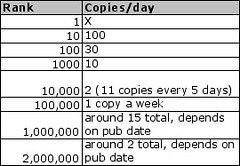Analyzing a Publisher's Potential
Evaluating a publisher’s potential for future printing business is one of the hardest things to do. I learned early in my career not to make judgments about future potential because I never got it right. The authors or publishers that I thought would become successful disappeared and never returned to reprint their books while the ones I thought wouldn’t make it kept returning for reprints. The best strategy, I found, is to treat all author/publishers equally. The trick to success is to learn as much as you can about their marketing and find ways to help them reach their audience.
There are rules of thumb that help determine if the author/publisher will have sufficient demand for the book. Gordon Burgett, author of the book Publishing for Niche Markets, suggests that the minimum reading population for a book should be 200,000 readers. So, in my conversations with author/publishers I ask, “Who will read your book?” When I hear “Everyone will want to read my book,” I sense an unsophisticated author/publisher and I know I have an opportunity to influence the choice of printed marketing tools they select.
Another way to measure potential demand for a title is to determine what quantities are similar titles selling. If the author/publisher hasn’t already done so, send them to several bookstores (including Amazon.com) to search for similar titles. Give them a spreadsheet to capture data on the various competing titles. Ask them to capture: the title, the author, the publisher, the ISBN number, the trim size, the page count, whether it is hard cover or paperback, whether it has a 1-, 2- or 4-color cover or dust jacket, the price of the book and the publication date. If you want a sample data capture form, contact me.
This completed form serves many purposes, the first of which is to determine the numbers of competitive books sold. I will discuss other uses for this form in future articles. Books are sold in a variety of distribution channels. Bookstores and Amazon are the easiest to track and make to use to estimate. To estimate how a book is selling through the bookstore channel, use the ISBN number to track its sales through Ingram. Ingram is the largest wholesaler of books to the bookstore trade. Call their automated telephone system at 615-213-6803 and follow the prompts. If the ISBN number you are inputting includes the letter X, press star instead of X. If the book is from a major publisher that sells directly to bookstores, then Ingram represents about 20% of total book sales. If the publisher is small without its own sales force, then Ingram may represent as much as 40% of a title’s sales. Since most bestsellers come from larger publishing houses, multiple Ingram’s sales figures by five to get a rough estimate of book sales.
Amazon sales are easier to estimate, the sales ranking is placed on the web page for each book. Enter the ISBN number into the search dialog box and it will take you to the web page for that title. Scroll down until you see the sales ranking. Interpreting the sales ranking is easier when using this chart:
This chart goes with the March 14, 2005 post.
Another rule of thumb is the number of titles the author/publisher already has in print. There is no hard-and-fast rule, but my experience indicates that if the author/publisher has three or more titles in print, there is a higher probability of repeat business. Three titles is also the “tipping point” where the author/publisher stops being a hobbyist and becomes a businessperson.


0 Comments:
Post a Comment
<< Home